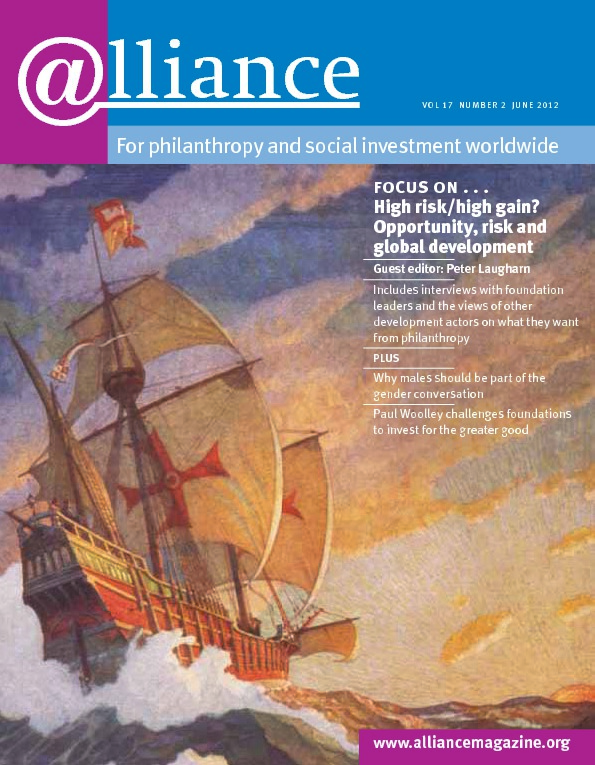It is said that endowed charitable foundations have great freedom. Possession of assets – exclusively in the control of the board – means that foundations can decide what they want to do without reference to other funders, the government or shareholders. But if you sit on a board, or work for a foundation, it doesn’t always feel like that. Research I recently carried out led me to conclude that certain false assumptions may be holding foundations back from making the most of what they have, in terms of both investment and expenditure.
 When they come to invest, foundations often find themselves treated as pension funds. And why not? They are both around for the long term; they both have money to invest and want a return year after year.
When they come to invest, foundations often find themselves treated as pension funds. And why not? They are both around for the long term; they both have money to invest and want a return year after year.
In fact their positions are very different. Pension funds’ whole operation is geared towards meeting the quantifiable future liabilities of known beneficiaries – those who have paid into the fund. Charitable foundations have a different relationship with their beneficiaries. They do not exist to provide money for specific individuals but to pursue certain charitable aims. Foundation board members are therefore free to decide who their beneficiaries are, expanding or contracting their number and the level of expenditure as grant programmes change and develop. This freedom means that, at least in theory, foundations can tolerate greater risk because they are less concerned with the volatility of investment return than pension funds, whose regulatory framework requires them to maintain the value of their assets so that they can always meet their predicted future liabilities.
No one likes to cut expenditure. So at the very least, foundations don’t have to react to annual fluctuations. Instead, if they carefully monitor the value of the endowment over a timescale that’s right for them, the board can maintain even expenditure by knowing when to put the brake on – or indeed discover that it is safe to increase spend as markets rise.
The freedom foundations have relates to both spending and investing. Pension funds and private trusts put money first. They needn’t be concerned with how the money they generate is spent. Foundations, on the other hand, exist only to fulfil certain charitable goals. In that sense the asset is secondary – it’s the means to the charitable ends.
Looking at all their activity through the single lens of their mission can reveal for boards a much bigger range of tools than they may at first think of. For example, the Nuffield Foundation puts money into life sciences both as part of its investment portfolio and in grants. Many foundations connect their mission and investment activity by applying ethical screening to their portfolio. In England and Wales, the Charity Commission has produced pragmatic and permissive investment guidance for those that want to combine financial and social returns in the same investment.
The range of options is even wider than using money. Foundations, when they think about how to pursue their charitable aims, have at their disposal the entire balance sheet, including the reputation of the organization and the human capital of staff and board members. A well-respected foundation can raise awareness about social issues and help change behaviour through using its name and brand, and many foundations recognize that expert staff can help build the capacity and effectiveness of the organizations they fund.
The biggest unfounded assumption I came across concerns permanence. Most people believe that the default position for foundations is perpetuity. In fact, unless the donor has explicitly stipulated that they are permanent, boards have freedom to determine for themselves the timescale that best suits the mission. Some foundations therefore choose to tackle pressing social problems today rather than saving money for tomorrow. One example is the Bill and Melinda Gates Foundation, which will ‘spend out’ on research and prevention of infectious diseases such as HIV/AIDS and malaria.
Of course, for good reasons boards may want to ensure that their work continues in the long term, and preserving the endowment is then a natural goal. But preservation as a goal in itself mustn’t trump the charitable mission. The impact of this freedom is that boards can regularly question, in terms of their mission, whether the foundation is necessary and how it is relevant. Thinking that through, with all the means at their disposal, could suggest a greater, and more creative, range of options than might at first be apparent.
Richard Jenkins is a charity and foundation specialist. Email mail@richardjenkinsconsulting.com
For more information
The Governance and Financial Management of Endowed Charitable Foundations by Richard Jenkins is available for download free at http://www.acf.org.uk/publicationsandresources/publications






Comments (0)